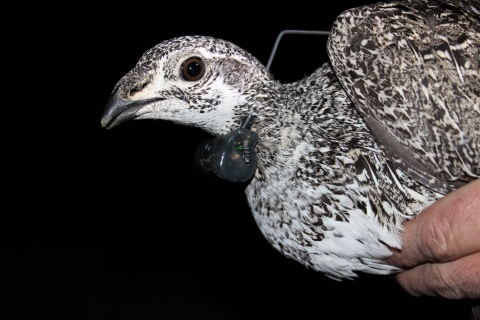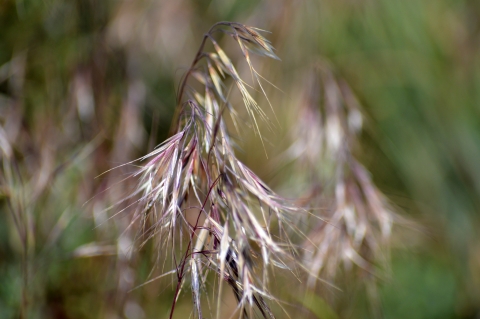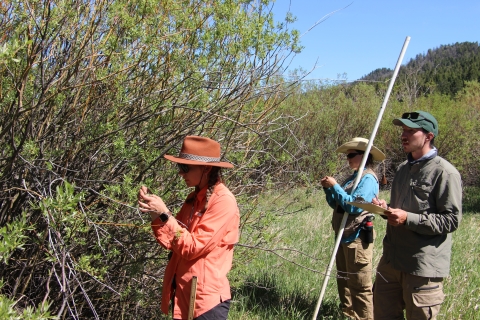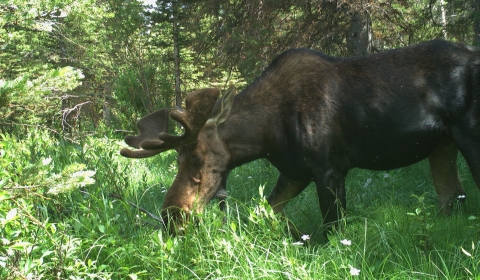What We Do
Red Rock Lakes National Wildlife Refuge is a conservation leader in the Centennial Valley working with others create and sustain native habitat for migratory fish and wildlife.
Management and Conservation
The ongoing conservation efforts at Red Rock Lakes National Wildlife Refuge aim to provide habitat for breeding and staging migratory birds, native fishes, and both resident and migratory wildlife that maintains the biological diversity and integrity of this montane wetland system.
Management Plan
The Comprehensive Conservation Plan sets the direction for management and use of the Refuge, and includes the following major actions:
- Maintain high productivity in wetlands to benefit nesting and migrating trumpeter swans and other waterfowl.
- Restore two modified wetlands (32 acres) back to a free-flowing, historical spawning stream for the lower 48 states’ last known population of adfluvial Arctic grayling fish. (Adfluvial: lake inhabitant that breeds in a river.)
- Increase opportunities for environmental education and interpretation to better orient visitors to the values of the Refuge and the Centennial Valley.
- Provide and expand opportunities for quality hunting and fishing experiences while ensuring that trumpeter swans and other priority migratory birds have protected resting areas.
Comprehensive Conservation Planning
The purpose of a CCP is to specify a management direction for the Refuge for the next 15 years. The goals, objectives, and strategies for improving Refuge conditions, including the types of habitat we will provide, partnership opportunities, and management actions needed to achieve desired conditions, are described in the CCP. The Service’s preferred alternative for managing the Refuge and its effects on the human environment, are described in the CCP as well.
The Refuge System is managed by the Fish and Wildlife Service (Service), an agency within the U.S. Department of the Interior. The Service is the primary Federal entity responsible for conserving and enhancing the Nation’s fish and wildlife populations and their habitats. Although the Service shares this responsibility with other Federal, State, tribal, local, and private entities, the Service has specific trust resource responsibilities for migratory birds, threatened and endangered species, certain anadromous fish, certain marine mammals, coral reef ecosystems, wetlands, and other special aquatic habitats. The Service also has similar trust responsibilities for the lands and waters it administers to support the conservation and enhancement of all fish and wildlife and their associated habitats.
Our Services
Be Prepared
Red Rock Lakes is a remote site that is at least 40 miles from the nearest gas station, store, or mechanic shop. The gravel roads can be rough on tires and vehicles can get stuck in snow or mud, so vehicles with 4-wheel drive and high clearance are recommended. Cell service is also limited for most carriers, so we encourage visitors to check in with someone they know or carry a satellite device for communication. Our facilities and staff are unable to provide maintenance, fuel, or repair services to the public, so we recommend arriving with a full fuel tank, a spare tire, patch kit, and an inflator.
Visitor Center
With the exception of federal holidays, we are open on Monday through Friday from 8:00 AM to 4:30 PM.
Wheelchair-accessible public restrooms and a bottle filling station are available to visitors during open hours. A vault toilet outside is available when the visitor center is closed. Picnic tables are set up during summer months, but there are no public waste disposal facilities and trash must be packed out.
From grade school to college, we are able to accommodate school groups and can facilitate curriculum-specific learning experiences for students during their visit. To coordinate your school group visit, reach out to our Refuge Manager.
Campgrounds
Red Rock Lakes operates two primitive campgrounds with sites available on a first come, first served basis.
Our Projects and Research
Wilderness Stewardship
It's about what we don't do! A large part of Red Rock Lakes National Wildlife Refuge is designated wilderness. As we carry out our fieldwork, we consider the impacts of our activities and how we can exemplify values that preserve wilderness character. To access wilderness areas for fieldwork, we travel on foot, on skis, or in canoes and kayaks to preserve the tranquil soundscape of the Centennial Valley.
Ecological Restoration
The Refuge is a wild place in a remote location, but even here human activity impacts the landscape. Management of the Refuge includes removing the marks left by past generations and building ecosystem resilience.
Invasive Species ControlThe Centennial Valley is an especially remote place with fewer vectors for invasive species invasive species |
Grassland ReplantingFive acres were restored in a field formerly inundated with invasive grasses near Red Rock Lakes National Wildlife Refuge headquarters. Eight species of native grasses and twelve species of native flowering forbs combining with some already present native forbs are expected to provide improved habitat for pollinators, birds, and mammals. In addition to returning this field to its fully functioning ecosystem state, we hope this demonstration plot will enhance the visitor experience. In the years following the planting, the blooming wildflowers have attracted many species of native pollinators. |
Odell Creek Trail Aspen GroveVolunteers, technicians, and Refuge staff planted thousands of aspen tree seedlings for a Refuge timber improvement project site to help mitigate wildfire danger near the Refuge headquarters. Aspen seeds were hand collected from several different mother trees around the Refuge and sent to the Montana Department of Natural Resources and Conservation (DNRC) seedling nursery for propagation. The resulting containerized seedlings were planted over multiple years and covered about five acres, surrounded by fencing to protect the young trees from browsing pressure as they grew. |
Whitebark PineThe range of the endangered whitebark pine (Pinus albicaulis) extends throughout the Greater Yellowstone Ecosystem, including the high mountainous areas of Red Rock Lakes. We partnered with the Montana DNRC nursery, the only other facility producing whitebark pine seedlings besides the Forest Service nursery in Coeur d'Alene, to propagate plants from seed collected on the Refuge. We are participating in the whitebark pine working group of the Greater Yellowstone Coordinating Committee (GYCC) to preserve this important tree species as it faces threats of climate change climate change |
Monitoring and Management
PollinatorsThe state of Montana is home to over two dozen native bumblebee species, many of which make their home in the Centennial Valley. A few particularly interesting species have been documented on the Refuge, including the Western bumblebee (Bombus occidentalis) and Suckley's cuckoo bumblebee (B. suckleyi). We plan to continue monitoring for these species and others in partnership with The Xerces Society for Pollinator Conservation. |
Willow BrowseTechnicians identify different species of willows and perform browse surveys to assess the level of moose herbivory, its effect on overall willow community health, and subsequent ecosystem effects. Data collected will help assess browse pressure exhibited by moose. Willows provide important habitat for songbirds and winter food resources for several ungulate species, so understanding browse impact is important in determining willow community health. |
Camera TrapsWe have a series of remote camera traps set up in the mountains to detect large mammal activity. The Refuge is within the range of three endangered carnivores: the grizzly bear (Ursus arctos horribilus), Canada lynx (Lynx candensis), and wolverine (Gulo gulo). |
Bluebird TrailThe Centennial Valley Bluebird Trail is a series of post-mounted nest boxes stretching over 18 miles along South Valley Road. It is comprised of over 90 boxes and provides valuable brood rearing habitat to cavity-nesting songbirds such as mountain bluebirds (Sialia currucoides) and tree swallows (Tachycineta bicolor). Volunteers and seasonals monitor nestling development and record survivorship, species composition, and timing of fledging each year. |
Arctic Grayling Adaptive Management Plan
Red Rock Lakes is home to a population of arctic grayling (Thymallus arcticus) that have been experiencing a steep decline in recent years. The U.S. Fish & Wildlife Service has formed a partnership with Montana Fish Wildlife & Parks to monitor and manage the fish population and habitat in the lakes and streams throughout the Centennial Valley. Scientists from both organizations have worked together to determine the factors affecting the species' decline and have developed a plan of action to support these fish through habitat projects and partnerships with land owners.
Winter HypoxiaUpper Red Rock Lake, which only 6 feet at its deepest point, is important winter habitat for grayling as they move to colder water containing more dissolved oxygen. When the first few feet on the surface of the lake freeze, this leaves less available water from which the fish can extract oxygen, a condition called hypoxia. Hypoxic conditions are thought to be a major component of why the arctic grayling population is in decline, so researchers measure ice depth and dissolved oxygen levels at different depths to determine the amount of suitable winter habitat available from year to year. |
Law Enforcement
U.S. Fish & Wildlife Law Enforcement officers work closely with surrounding Federal, State, and Local Law enforcement agencies to help facilitate all visitors' quality experience while on the Refuge.










